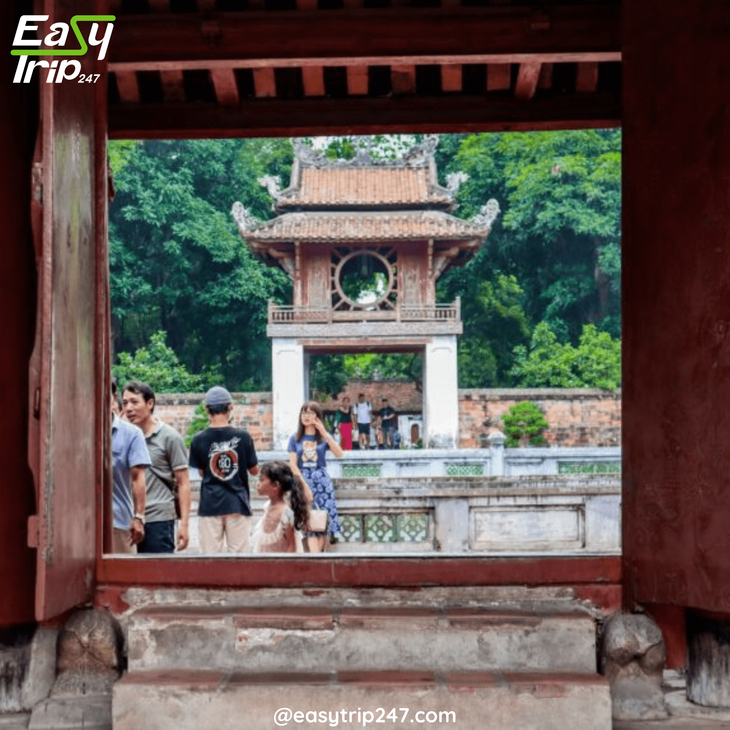Temple of Literature or Imperial Academy: Understanding the Difference
On
23/06/2025Reading time:
1 min
Summary:
When exploring Vietnam’s rich cultural and educational heritage, the Temple of Literature Hanoi and the Imperial Academy often come up together—sometimes even interchangeably. For visitors, students, and even locals, it can be confusing to distinguish between these two historical entities.

Let’s begin with the Temple of Literature Hanoi, one of the most iconic landmarks in Vietnam’s capital. Constructed in 1070 during the reign of Emperor Lý Thánh Tông, it was initially dedicated to Confucius and became a site for honoring scholars and the importance of education. The Temple of Literature Hanoi was modeled after the original Temple of Confucius in Qufu, China, and functioned as a Confucian sanctuary—a sacred place to venerate the great teacher and philosopher whose ideas shaped not only Chinese civilization but also Vietnam’s moral and intellectual frameworks.
While the Temple of Literature Hanoi was the spiritual and philosophical foundation, the Imperial Academy—known in Vietnamese as "Quốc Tử Giám"—was established just a few years later in 1076. It was built within the same complex, effectively transforming the site into both a temple and Vietnam’s first national university. This distinction is critical. While the Temple of Literature Hanoi was primarily a place of worship and symbolic learning, the Imperial Academy was a working educational institution where students actually studied, trained, and took rigorous examinations.
In essence, the Temple of Literature Hanoi and the Imperial Academy are two closely linked but fundamentally different institutions. The former is a temple honoring Confucius and celebrated scholars, while the latter is an academic facility built within its grounds. Over the centuries, this combined space became a hub for intellectual development and the cultivation of the nation’s elite. Understanding this duality helps visitors appreciate that the Temple of Literature Hanoi wasn’t just a temple—it was the beating heart of Vietnam’s classical education system.
The architectural layout of the site reflects this dual purpose. As you enter the Temple of Literature Hanoi, you pass through five courtyards. The earlier courtyards are peaceful, almost meditative, featuring ancient trees, lotus ponds, and stone pathways meant for contemplation. These areas represent the temple's role as a spiritual and cultural sanctuary. Moving deeper into the complex, you encounter the more academic elements: the pavilions and halls where scholars would have studied, taken exams, and been evaluated for civil service positions.
Perhaps one of the most enlightening features of the Temple of Literature Hanoi is the Stelae of Doctors. These 82 stone stelae are mounted on the backs of stone turtles and bear the names of graduates from the Imperial Academy who passed the royal examinations between 1442 and 1779. These stelae, now protected as national treasures, are a proud testimony to Vietnam’s emphasis on academic merit. They stand as physical proof of the distinction between the symbolic purpose of the temple and the functional role of the academy.
The curriculum at the Imperial Academy was rigorous and deeply rooted in Confucian teachings. Students were typically from noble or scholarly families, and many began their studies at a young age. The emphasis was on moral integrity, classical Chinese texts, history, and the principles of governance. Only the best and brightest were able to pass the difficult civil service exams, which were designed to identify individuals capable of serving the country. The Temple of Literature Hanoi provided the spiritual backdrop for this intellectual journey, while the Imperial Academy delivered the education needed to walk that path.
Over time, the role of the Imperial Academy evolved. Under the Lê and Nguyễn dynasties, it expanded its curriculum and opened up to more students. However, its prominence declined with the arrival of French colonial rule in the late 19th century, which introduced Western-style education and diminished the influence of Confucian-based schooling. Still, the Temple of Literature Hanoi remained a revered cultural and historical site, preserving the memory of the Imperial Academy’s educational contributions.
Today, when people refer to the Temple of Literature Hanoi, they are often referring to the entire complex—including the remains of the Imperial Academy. The distinction between the temple and the academy has blurred in popular understanding, but the physical layout and historical records still make it possible to trace their individual roles. Efforts by historians, cultural preservationists, and educators continue to clarify these differences, ensuring that visitors can fully grasp the richness of what they’re seeing when they explore this magnificent site.
Visiting the Temple of Literature Hanoi provides a deeper, layered experience when one understands this dual identity. You’re not just visiting a temple—you’re stepping into Vietnam’s oldest university, a place where tradition, spirituality, and academia coexisted in perfect harmony. It’s a place that speaks not only to the Vietnamese people’s deep respect for learning but also to the way education was once inseparable from moral and civic development.
Tour guides often point out how these roles are still honored today. Students in Hanoi and across Vietnam visit the Temple of Literature Hanoi to pray for success before exams, sometimes tying red ribbons or placing offerings at altars. These rituals may appear modern, but they echo centuries-old traditions that link back to the Imperial Academy’s days of scholarly discipline. For students and visitors alike, the temple serves as a source of inspiration—both spiritual and intellectual.
In conclusion, while the Temple of Literature Hanoi and the Imperial Academy share the same physical space, they served different yet complementary functions in Vietnamese history. The temple symbolizes the philosophical heart of Vietnamese education, while the academy represents its practical execution. Understanding this difference allows for a richer, more meaningful visit. The next time you step through the ancient gates of the Temple of Literature Hanoi, remember: you are not only entering a temple, but also the remnants of a university that once shaped the destiny of a nation.
Design Your Tour Today And Get A Quote. Contact Us Here: +84.975.504.825
Source: Easytrip247 Team compiled.
